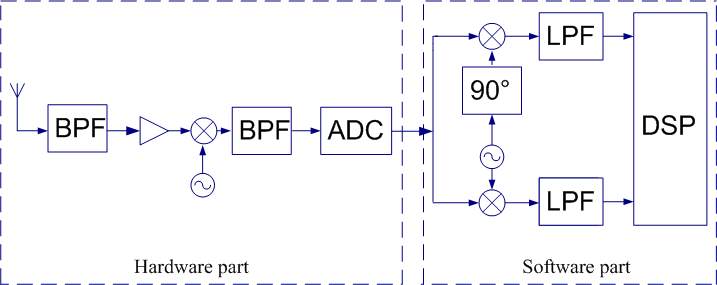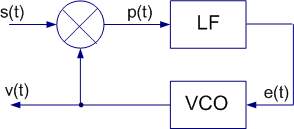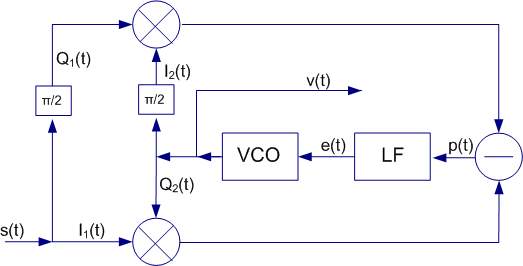Abstract
Contents
- Introduction
- 1. Theme urgency
- 2. Goal and tasks of the research
- 3. The concept for construction of software-based heterodyne
- Conclusion
- References
Introduction
Software Defined Radio (SDR) technology is a promising direction of development of modern telecommunications equipment. The term SDR has some fuzzy meaning, but when we talk about radio receivers, it means that their main parameters are determined by software. Such a determination is made by an international organization for programmable radio called the SDR Forum [1].
SDR technology is used by the military, telecommunications companies, companies producing telecommunication equipment and radio amateurs [2].
SDR is a good technology to researchers in the field of telecommunications. Approach allows us to explore new methods of signal processing, test theories, without expensive and time consuming for the researcher reconfiguration hardware base.
1. Theme urgency
Modern telecommunications equipment, including receivers, consists of hardware and software parts (SDR). Software implementation of the main functions of the receiver allows the introduction of new algorithms for digital signal processing (DSP), which extend the functionality of SDR receivers.
Telecommunication signals are often subjected to various distortions (atmospheric interference, multipath signals, the influence of the Doppler effect). Modern mobile standards require high-quality signal (for example, a GSM frequency instability should not exceed 10e–6 Hz) [3]. There is a contradiction between the strict requirements for quality of the received signal and the actual signals from the input of the receiver.
Receiver has different properties depending on environmental conditions that can lead to deterioration in the quality of the received signal. To compensate these changes we need to control the amplitude and the phase of the heterodyne signal, which is problematic in hardware implementation.
2. Goal and tasks of the research
Program heterodyne of SDR receiver on the basis of a phase-locked loop (PLL) can solve these problems. Therefore, the work is devoted to research and development of methods for constructing heterodynes of SDR receivers based on the software PLL.
Extending the functionality of SDR receivers through the use of advanced software-based PLL-heterodyne is the goal of the research. To achieve the goal it is necessary to:
- Make the requirements for PLL-based software heterodyne.
- Synthesize the structural scheme of the software-based heterodyne.
- Simulate the work of the software-based heterodyne.
- Analyze the simulation results to improve the scheme.
- Develop the recommendations for constructing of software-based heterodyne.
3. The concept for construction of software-based heterodyne
The books [2], [4–6] contain a description of different SDR receivers schemes. There are direct conversion receivers and superheterodynes. PC’s soundcard is very slow for most of the SDR applications. That is why we need to use external heterodyne (superheterodyne scheme). Suitable scheme is shown in figure 1. This receiver uses IQ signals for advanced DSP techniques.

Figure 1 – Superheterodyne receiver with digital intermediate frequency
Where LPF is for lowpass filter, BPF is for bandpass filter.
We will use the PLL-based oscillator to achieve the goal of the research. PLL are described in works [7–10]. There are also some interesting works of DonNTU students in this area, such as [11–15].
Classic PLL loop (fig. 2) consists of phase detector (PD), loop filter (LF) and voltage-controlled oscillator (VCO) [8].

Figure 2 – PLL Loop
Input signal s(t) has frequency ω and phase Θ:

|
(1) |
VCO signal has different phase – Ω:

|
(2) |
PD output signal p(t) is written:

|
(3) |
For equal frequencies of input and VCO signals we have:

|
(4) |
LF cut off 2ω frequency, then e(t) control the VCO full phase Ф(t):

|
(5) |
where К0 – VCO proportionality coefficient.
Therefore, we can easily implement PD and VCO in software. PD is implemented as multiplier. VCO is implemented as math function sin(x) and integrator.
We need second-order PLL system to track signal with unstable frequency and phase. We need first-order LF, because VCO is first-order system (one order of LF and one order of VCO determine the second order of whole PLL system) [16]. It is better to use proportional-integral (PI) regulator as first order LF. [17] gives formula for its software implementation:

|
(6) |
where Ki and Kp – integral and proportional coefficients PI controller.
SDR receiver (fig. 1) uses IQ signals. Therefore we can use advanced PD, which has not cumulative frequency component:

|
(7) |
where '1 'and '2' relate input and VCO signals.
For Q component generation we use Hilbert filter. Keep in mind, that Low orders of Hilbert filter bring distorted signal, and high orders bring big group delay [18].
A scheme of software-based heterodyne is shown in figure 3.

Figure 3 – Proposed scheme of software-based heterodyne
Software for simulation of the software-based heterodyne was developed. Algorithm can be found in [19].
The main advantage of this approach is the ability to work with real signals. This ensures that one of the major limitations of SDR receiver, connected with limited PC soundcard as the ADC abilities, will be taken into account.
Visual C++ 2010 Express [20] was used with standard libraries. Fast Fourier transform library can be found in [21]. Programming fundamentals for Windows shown in [22]. Fundamentals of working with data from the buffer of sound card are given in [23], [24]. Hilbert filter coefficients calculated in MATLAB [25].
Signals from the generator of harmonic signals were fed to the microphone input of the sound card of PC, where the program was running. The main window displays the input signal and its spectrum (left), and the output signal and its spectrum (right). Figure 4 shows, that PLL-based heterodyne tracks signal.

Figure 4 – Acquisition of the input signal
(animation: 7 shots, 7 cycles of repetition, 140 kilobytes)
The developed model allows us to see that when you configure the heterodyne for a quick capture of the signal, it becomes noisier. Corresponding math equations can be found in [8], [9], but they are very approximate.
Conclusion
This work proposes to use PLL-based program heterodyne to extend the functionality of SDR receiver. Structure of the system was selected and software for simulation of the software-based heterodyne was developed. Developed software confirmed the possibility of using the system in practice.
Studies have confirmed the basic contradiction of the PLL-based oscillator: with faster acquisition time we have lower stability of the signal given out, and vice versa. The main parameters that control the rate of capture and noise characteristics of the oscillator are the coefficients of the PI controller. Therefore, the direction of future research is developing of system with dynamic filter coefficients for the minimum acquisition time and good noise characteristics.
Note
The master’s thesis is not finished to the time of writing this abstract. The research is expected to be finished till December the 15th, 2011. Contact author or scientific advisor after this date to obtain the full text of the thesis.
References
- SDR forum [Электронный ресурс]. – Режим доступа: http://www.wirelessinnovation.org/.
- Kenington P.B. RF and baseband techniques for Software Defined Radio / P.B. Kenington. – Artech House, 2005. – 337 pp.
- Эффект Доплера в сетях: GSM, 3G, 4G [Электронный ресурс]. – Режим доступа: http://habrahabr.ru/....
- DeSimone M. Software-Defined Radio – An overview and tutorial / Mike DeSimone. – 2009. – 54 pp.
- Burns P. Software Defined Radio for 3G / Paul Burns. – Artech House, 2003 – 300 pp.
- Tuttlebee W. Software Defined Radio – Enabling technologies / Walter Tuttlebee. – John Wiley & Sons, 2002. – 428 pp.
- Шахгильдян В.В. Системы фазовой автоподстройки частоты / В.В. Шахгильдян, А.А. Ляховкин – М.: Связь, 1972. – 450 с.
- Best R.E. Phase-Locked Loops. Design, simulation, and applications / Roland E. Best. – McGraw-Hill, 2004. – 424 pp.
- Egan W. Phase-lock basics / William Egan. – John Willey & Sons, 2007. – 455 pp.
- Контур фазовой автоподстройки частоты и его основные свойства [Электронный ресурс]. – Режим доступа: http://www.dsplib.ru/....
- Аллилуйкина А.Д. Исследование ФАПЧ систем синхронизации в радиочастотных каналах телекоммуникационных сетей [Электронный ресурс]. – Режим доступа: http://masters.donntu.ru/....
- Бурховецкий В.Д. Исследование аналоговой ФАПЧ в цифровом канале связи [Электронный ресурс]. – Режим доступа: http://masters.donntu.ru/....
- Нестеренко А.С. Исследование методов и средств фазовой синхронизации в спутниковом канале [Электронный ресурс]. – Режим доступа: http://masters.donntu.ru/....
- Волкова А.А. Исследование методов повышения достоверности приема дискретных сигналов в радиоканале с использованием демодуляторов на основе ФАПЧ [Электронный ресурс]. – Режим доступа: http://masters.donntu.ru/....
- Даниленко С.И. Исследование и усовершенствование синхрогенератора на основе ФАПЧ с улучшенными характеристиками захвата и слежения [Электронный ресурс]. – Режим доступа: http://masters.donntu.ru/....
- Цифровой контур ФАПЧ (digital PLL) и его свойства [Электронный ресурс]. – Режим доступа: http://www.dsplib.ru/....
- Nezami M.K. RF architectures & digital signal processing aspects of digital wireless transceivers / Mohamed K. Nezami. – Draft, 2003. – 513 с.
- Лайонс Р. Цифровая обработка сигналов / Ричард Лайонс. – М.: Бином, 2006. – 656 с.
- Зюмін С.А. Використання програмних ФАПЧ в SDR технологіях / С.А. Зюмін. – Сучасні інформаційні технології та програмне забезпечення комп’ютерних систем. Збірник тез доповідей Всеукраїнського студентського науково-практичного семінару. – Кіровоград, "Код" – 2012, с. 16-18.
- Visual C++ 2010 Express [Электронный ресурс]. – Режим доступа: http://www.microsoft.com/....
- Быстрое преобразование Фурье, листинг программы [Электронный ресурс]. – Режим доступа: http://psi-logic.narod.ru/....
- Петзолд Ч. Программирование для Windows 95 / Ч. Петзолд. – СПб.: БХВ-Петербург, 1997. – Том I. – 495 с.
- Музыченко Е. Низкоуровневое программирование звука в Windows [Электронный ресурс]. – Режим доступа: http://www.compress.ru/....
- Тарасенко А. Работа со звуковой картой в Windows [Электронный ресурс]. – Режим доступа: http://junglewin.narod.ru/....
- MATLAB Trial Download and Videos [Электронный ресурс]. – Режим доступа: http://www.mathworks.com/....
